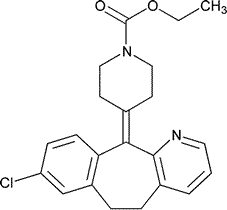Loratadine
1-Piperidinecarboxylic acid,4-(8-chloro-5,6-dihydro-11H-benzo[5,6]cyclohepta[1,2-b]pyridin-11-ylidene)-,ethyl ester.
Ethyl 4-(8-chloro-5,6-dihydro-11H-benzo[5,6]cyclohepta[1,2-b]pyridin-11-ylidene)-1-piperidinecarboxylate [79794-75-5].
»Loratadine contains not less than 98.5percent and not more than 101.0percent of C22H23ClN2O2,calculated on the dried basis.
Packaging and storage—
Preserve in well-closed containers,and store between 2 and 30
and 30 .
.
USP Reference standards á11ñ—
USP Loratadine RS.
Identification—
A:Infrared Absorption á197Mñ.
B:
The retention time of the major peak in the chromatogram of the Assay preparationcorresponds to that in the chromatogram of the Standard preparation,as obtained in the Assay.
Loss on drying á731ñ—
Dry it at 100 to constant weight:it loses not more than 0.5%of its weight.
to constant weight:it loses not more than 0.5%of its weight.
Residue on ignition á281ñ:
not more than 0.1%.
Heavy metals,Method IIá231ñ:
0.001%.
Related compounds—
Mobile phaseandDiluent—
Prepare as directed in the Assay.
Standard stock solution—
Prepare as directed for Standard preparationin the Assay.
Standard solution—
Pipet 5.0mLof Standard stock solutioninto a 100-mLvolumetric flask,dilute with Diluentto volume,and mix.Dilute quantitatively,and stepwise if necessary,with Diluentto obtain a solution having a known concentration of about 0.8µg per mL.
Test solution—
Use the Assay preparation.
Chromatographic system (see Chromatography á621ñ)—
The liquid chromatograph is equipped with a 254-nm detector and a 4.6-mm ×15-cm column that contains 5-µm packing L7.The column temperature is maintained between 25 and 35
and 35 .The flow rate is about 1mLper minute.Chromatograph the Test solution,and record the peak areas as directed forProcedure:the relative retention times are about 0.79for 4-(8-chloro-11-fluoro-6,11-dihydro-5H-benzo[5,6]cyclohepta[1,2-b]pyridin-11-yl)-1-piperidinecarboxylate ethyl and 1.0for loratadine.Chromatograph the Standard solution,and record the peak area of the main peak as directed for Procedure:the relative standard deviation for replicate injections is not more than 4.0%.
.The flow rate is about 1mLper minute.Chromatograph the Test solution,and record the peak areas as directed forProcedure:the relative retention times are about 0.79for 4-(8-chloro-11-fluoro-6,11-dihydro-5H-benzo[5,6]cyclohepta[1,2-b]pyridin-11-yl)-1-piperidinecarboxylate ethyl and 1.0for loratadine.Chromatograph the Standard solution,and record the peak area of the main peak as directed for Procedure:the relative standard deviation for replicate injections is not more than 4.0%.
Procedure—
Separately inject equal volumes (about 50µL)of the Test solutionand the Standard solutioninto the chromatograph,record the chromatograms,and measure all of the peak areas in the Test solutionand the peak area of the main peak in the Standard solution.Calculate the percentage of each impurity in the portion of Loratadine taken by the formula:
10,000(C/F)(ri/rS)/W,
in which Cis the concentration,in mg per mL,of USP Loratadine RSin the Standard solution;Fis the relative response factor for each impurity,if known,(Fis 0.25for 4-(8-chloro-11-fluoro-6,11-dihydro-5H-benzo[5,6]cyclohepta[1,2-b]pyridin-11-yl)-1-piperidinecarboxylate ethyl);riis the peak area response for each impurity in the Test solution;rSis the peak area response of loratadine in the Standard solution;and Wis the quantity,in mg,of Loratadine taken to prepare the Test solution:not more than 0.2%of 4-(8-chloro-11-fluoro-6,11-dihydro-5H-benzo[5,6]cyclohepta[1,2-b]pyridin-11-yl)-1-piperidinecarboxylate ethyl is found;not more than 0.1%of any other individual impurity is found;and not more than 0.3%of total impurities is found.
Assay—
0.01M Dibasic potassium phosphate—
Transfer about 1.74g of anhydrous dibasic potassium phosphate to a 1000-mLvolumetric flask,dissolve in and dilute with water to volume,and mix.
0.6M Dibasic potassium phosphate—
Transfer 105g of anhydrous dibasic potassium phosphate to a 1000-mLvolumetric flask,dissolve in and dilute with water to volume,and mix.
Mobile phase—
Prepare a filtered and degassed mixture of 0.01M Dibasic potassium phosphate,methanol,and acetonitrile (7:6:6).Adjust with 10%phosphoric acid solution to an apparent pHof 7.2.Make adjustments if necessary (see System Suitabilityunder Chromatography á621ñ).
0.05N Hydrochloric acid—
Transfer 500mLof water to a 1000-mLvolumetric flask,add 83mLof hydrochloric acid,dilute with water to volume,and mix.Transfer 50mLof this solution into a 1000-mLvolumetric flask,dilute with water to volume,and mix.
Diluent—
Transfer 400mLof 0.05N Hydrochloric acidand 80mLof 0.6M Dibasic potassium phosphate to a 1000-mLvolumetric flask,dilute with a mixture of methanol and acetonitrile (1:1)to volume,and mix.
Standard preparation—
Dissolve an accurately weighed quantity of USP Loratadine RSin Diluent,and dilute quantitatively,and stepwise if necessary,to obtain a solution having a known concentration of about 0.4mg per mL.
Assay preparation—
Transfer about 40mg of Loratadine,accurately weighed,to a 100-mLvolumetric flask,dissolve in and dilute with Diluentto volume,and mix.
Chromatographic system (see Chromatography á621ñ)—
The liquid chromatograph is equipped with a 254-nm detector and a 4.6-mm ×15-cm column that contains 5-µm packing L7.The flow rate is about 1mLper minute.The column temperature is maintained between 25 and 35
and 35 .Chromatograph the Standard preparation,and record the peak area responses as directed for Procedure:the relative standard deviation for replicate injections is not more than 2.0%.
.Chromatograph the Standard preparation,and record the peak area responses as directed for Procedure:the relative standard deviation for replicate injections is not more than 2.0%.
Procedure—
Separately inject equal volumes (about 15µL)of theStandard preparationand the Assay preparationinto the chromatograph,record the chromatograms,and measure the areas for the major peaks.Calculate the quantity,in mg,of C22H23ClN2O2in the portion of Loratadine taken by the formula:
100C(rU/rS),
in which Cis the concentration,in mg per mL,of USP Loratadine RSin the Standard preparation;and rUand rSare the peak area responses obtained from the Assay preparationand the Standard preparation,respectively.
Auxiliary Information—
Staff Liaison:Karen A Russo,Ph.D.,Scientist
Expert Committee:(PA1)Pharmaceutical Analysis 1
USP28–NF23Page 1149
Pharmacopeial Forum:Volume No.30(3)Page 891
Phone Number:1-301-816-8379
